

Ron Rubinstein - Software. Matlab Tools: These toolboxes combine Matlab M-code with optimized MEX functions written in C.

The source code is freely available for academic and personal use. The toolboxes are designed to be easy to use, and are fully documented - see the readme.txt file in each toolbox to get started. Also see the faq.txt file in each toolbox for some frequently asked questions. If you have any additional questions or comments, don't hesitate to contact me. Note: The packages will compile on Matlab v7.3 (R2006b) and up.
LAPACK — Linear Algebra PACKage. LAPACK is written in Fortran 90 and provides routines for solving systems of simultaneous linear equations, least-squares solutions of linear systems of equations, eigenvalue problems, and singular value problems.

The associated matrix factorizations (LU, Cholesky, QR, SVD, Schur, generalized Schur) are also provided, as are related computations such as reordering of the Schur factorizations and estimating condition numbers. Dense and banded matrices are handled, but not general sparse matrices. In all areas, similar functionality is provided for real and complex matrices, in both single and double precision. The original goal of the LAPACK project was to make the widely used EISPACK and LINPACK libraries run efficiently on shared-memory vector and parallel processors.
[Lapack] installation of lapack on a linux system. LAPACK — Linear Algebra PACKage. [Lapack] installation of lapack on a linux system. Inverted Indexes – Inside How Search Engines Work. An Inverted Index is a structure used by search engines and databases to make search terms to files or documents, trading the speed writing the document to the index for searching the index later on.

There are two versions of an inverted index, a record-level index which tells you which documents contain the term and a fully inverted index which tells you both the document a term is contained in and where in the file it is. For example if you built a search engine to search the contents of sentences and it was fed these sentences: {0} - "Turtles love pizza" {1} - "I love my turtles" {2} - "My pizza is good" Then you would store them in a Inverted Indexes like this: Record Level Fully Inverted "turtles" {0, 1} { (0, 0), (1, 3) } "love" {0, 1} { (0, 1), (1, 1) } "pizza" {0, 2} { (0, 2), (2, 1) } "i" {1} { (1, 0) } "my" {1, 2} { (1, 2), (2, 0) } "is" {2} { (2, 2) } "good" {2} { (2, 3) }
VLBennchmarks - Tutorials - Retrieval. The source code of this tutorial is available in retrievalDemo.m function, this text shows only selected parts of the code.

The current implementation does not support Microsoft Windows platforms. Retrieval benchmark The image retrieval benchmark tests feature extractorss in a simple image retrieval system. The retrieval benchmark closely follows the work Jegou et. al [1]. First a set of local features is detected by selected feature extractor, and described using selected descriptor. Lesson 5. Importing and exporting data: binary files A binary file contains data in its most compact form.
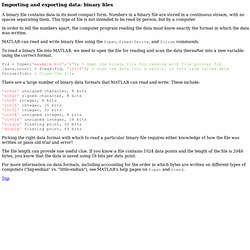
Numbers in a binary file are stored in a continuous stream, with no spaces separating them. This type of file is not intended to be read by person, but by a computer. In order to tell the numbers apart, the computer program reading the data must know exactly the format in which the data was written. MATLAB can read and write binary files using the fopen, fread/fwrite, and fclose commands. To read a binary file into MATLAB, we need to open the file for reading and scan the data thereafter into a new variable using the correct format. fid = fopen('example.bin','r'); % Open the binary file for reading with file pointer fid [data,count] = fread(fid, 'int16'); % Scan the data into a vector, in this case called data fclose(fid); % Close the file There are a large number of binary data formats that MATLAB can read and write. The file length can provide one useful clue. Top. Average precision. Evaluation of an information retrieval system (a search engine, for example) generally focuses on two things: 1.

How relevant are the retrieved results? (precision) 2. Did the system retrieve many of the truly relevant documents? (recall) For those that aren’t familiar, I’ll explain what precision and recall are, and for those that are familiar, I’ll explain some of the confusion in the literature when comparing precision-recall curves. Search Practical 2012. Instance-level Recognition Practical 2012 edition Andrea Vedaldi and Andrew Zisserman Introduction Getting started Exercise description Part I: Sparse features for matching specific objects in images Stage I.A: SIFT features detections Stage I.B: SIFT features descriptors and matching between images.
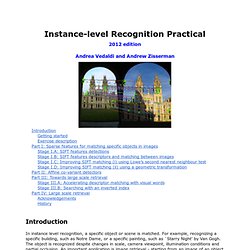
Peter's Functions for Computer Vision. To use these functions you will need MATLAB and the MATLAB Image Processing Toolbox.
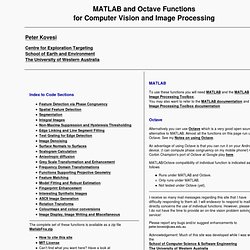
You may also want to refer to the MATLAB documentation and the Image Processing Toolbox documentation Octave Alternatively you can use Octave which is a very good open source alternative to MATLAB. Almost all the functions on this page run under Octave. See my Notes on using Octave. Change multiple files names. Extract all frames from video into images. A demonstration of bag-of-words classifiers. Walkthough of demo Sample images This is a sample of the images used for this demo.
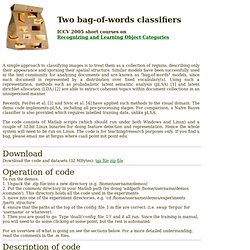
It contains a mix of faces from the Caltech face dataset and images from the Caltech background datasets. The do_preprocessing.m script should resize all of them to 200 pixels in width. Interset point operator Running do_interest_op.m calls the crude interest operator, Edge_Sampling.m. This runs a Canny Edge detector over the image and then samples points from the set of edgels.
Representation Running do_representation.m produces SIFT vectors for each interest point. Evaluation Running do_plsa_evaluation.m will then produce (after a few more EM iterations) several figures. Then the ROC and RPC curves are shown for classification task (face present/absent) only - the bag of words models cannot localize. Finally, some example images are plotted with the regions overlaid, coloured according to their preferred topic: Hands on Advanced Bag-of-Words Models for Visual Recognition. Hands on Advanced Bag-of-Words Models for Visual Recognition. Recognizing and Learning Object Categories. Bag of Words Models for visual categorization. Lately, I’ve been reading a lot about BOW (Bag of Words) models [1] and I thought it would be nice to write a short post on the subject.
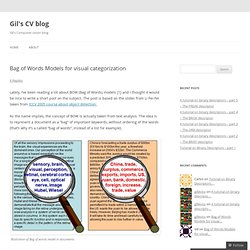
The post is based on the slides from Li Fei-Fei taken from ICCV 2005 course about object detection: As the name implies, the concept of BOW is actually taken from text analysis.